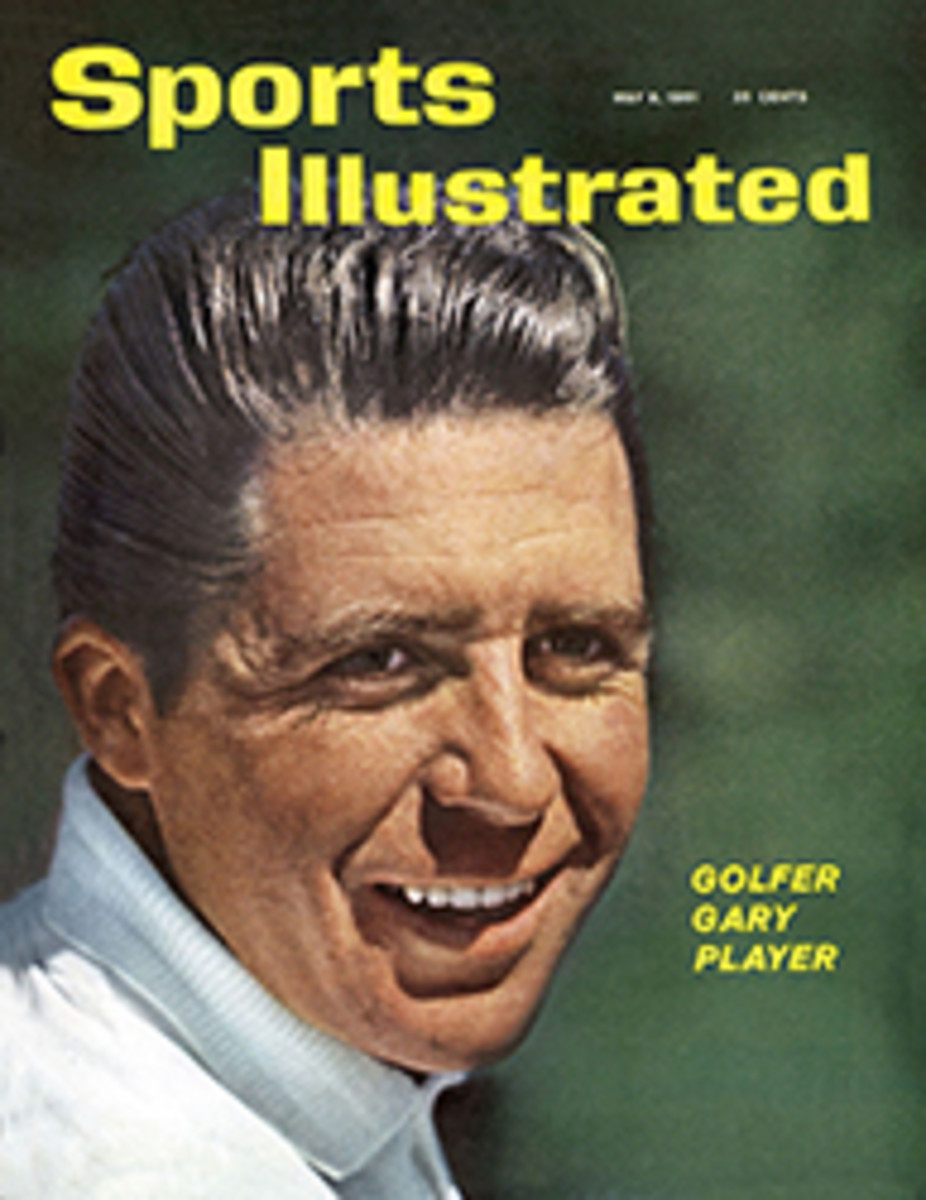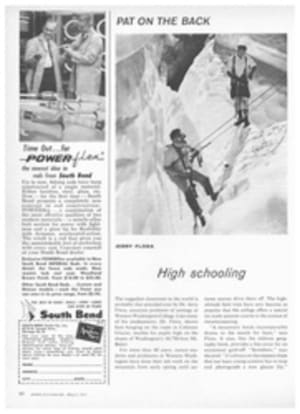
The 18 Strikeouts of Bob Feller
The sky was overcast, with temperatures in the 40s. A stiff wind blew across Lake Erie, sending dust swirling in tiny circles around Cleveland's mammoth Municipal Stadium. It was the last day of the major league baseball season (October 2, 1938), and a topcoat crowd of 27,000 was in the stands.
What brought the fans out for a double-header on that raw autumnal Sunday was not so much the third-place Cleveland Indians playing the fourth-place Detroit Tigers as watching First Baseman Hank Greenberg of the Tigers. Greenberg had 58 home runs and needed only two more to tie the record of 60, set 11 years earlier by Babe Ruth. He had failed to hit a home run in his previous three games, and the double-header was the last chance for the 6-foot-4, 215-pound slugger from The Bronx.
"The game scheduled for Saturday at League Park," Greenberg said recently, "was canceled to make the Sunday double-header at the stadium. The deep stretches of the stadium were always tough for a right-handed hitter like me," he said.
Cleveland's starting pitcher for the first game was Bob Feller, the young man with the high kick and the hard fast ball. Only two years away from his home on a Van Meter, Iowa farm, Feller stood to win his 18th of the season and was determined "to make Greenberg earn any home runs he hit off me."
Detroit's pitcher was Harry Eisenstat, a left-hander from Brooklyn, who began his career with the Dodgers. Eisenstat, a curve-baller with fine control, had an 8-6 record as he started the game for the Tigers.
Feller retired the Tigers easily in the first inning, striking out Second Baseman Benny McCoy and getting Pete Fox and Roy Cullenbine on routine plays.
"You've got it today," Cleveland Catcher Frank Pytlak told Feller between innings. Feller's curve broke sharply, and Pytlak, a good curve-ball catcher, was calling for it often. Eisenstat retired the Indians in order in the first inning, and the stage was set for Greenberg as he led off the second inning.
"It was dark, and I had trouble following the ball," Greenberg said. "Feller's curve was jumping wickedly and with that and his fast ball, he was murder."
Every swing counted
Greenberg dug in tenaciously against Feller. He had to make every swing count. Feller got two quick strikes on him, then threw a fast curve. Greenberg swung hard, missed, and the Cleveland crowd roared. Feller ended the inning with a flourish, striking out Chet Laabs and Tony Piet.
Cleveland couldn't get a hit off Eisenstat, and Detroit couldn't get a fair ball off Feller in the third. In the fourth, after Fox struck out, Cullenbine singled and Greenberg came to bat for the second time.
The shadow of the grandstand fell halfway between the pitcher's box and home plate. Feller was throwing from light into gloom. Many of the Detroit hitters later claimed this helped Feller. "Nonsense," says Bob, "I have been clobbered on days like this."
Greenberg swung hard in this half-light and went down swinging for the second time. "He was really firing the ball," Greenberg recalls. "It felt like an aspirin tablet in my hand," says Feller.
After Greenberg, Feller struck out Laabs for the second time. Bob now had 10 strikeouts in four innings. The record was 17, held jointly by Feller and Dizzy Dean of the St. Louis Cardinals.
Mark Christman and Eisenstat struck out in the fifth for Feller's 11th and 12th victims. The Indians still hadn't a hit off Eisenstat, Greenberg still hadn't a home run, and Feller was stealing the stage with his strikeouts.
Cullenbine started the sixth with a hard single. Greenberg, his chance fleeting, moved to the batter's box for his third try. After a strike Hank caught a fast ball and drove it on a line to left center field. "I knew when it left the bat," he said later, "it didn't have enough carry to clear the wall." The crowd howled as the ball struck the wall near the 380-foot mark.
"I was going to keep running and try for an inside-the-park homer," Greenberg remembers. But instead of bouncing at an angle and giving Greenberg a chance to run, the ball hit the wall evenly and bounced straight back into Center Fielder Roy Weatherly's hands. Greenberg stopped at second and looked forlornly toward center field.
Birdie Tebbetts followed with a double for two runs and a 2-0 Detroit lead. Feller settled down, striking out Laabs for the third time (No. 13) and Christ-man (No. 14) to end the inning.
The Detroit seventh began with Eisenstat (still protecting his no-hitter) becoming Feller's 15th strikeout. But McCoy and Fox rolled out to end the inning. Feller needed three more strikeouts for the record, and he carried a weary arm into the eighth inning.
"I was pointing the ball," Feller says now, "instead of throwing it."
The Cleveland pitcher walked Cullenbine and Greenberg in the eighth. Tebbetts sacrificed, but Laabs obliged by striking out for the fourth time (No. 16 for Feller). Piet walked, and Christ-man hit a curve for a single and two runs, after Feller had two strikes on him.
Bob then committed the cardinal sin for pitchers: he walked the opposing pitcher. McCoy followed with a line drive, which was caught to end the inning. Feller's chances for the record appeared slim.
In the bottom of the eighth Frank Pytlak hit a slow curve for a single. It was the first hit off Eisenstat.
Now the drama focused on Feller, alone, as he stood on the mound in the top of the ninth in the dark, cold, cavernous stadium.
"I felt strained and tired," Feller recalls. "I wouldn't have bet much on my chances."
Fox struck out on three pitches to start the last inning as Feller bore down. This tied his own mark; he needed just one more. Cullenbine, who hadn't struck out once, singled to right. The crowd groaned. Greenberg, hanging grimly to his fading hopes, hit a long fly to center field. Weatherly was able to back up and catch it. Greenberg was out, but Feller needed another strikeout. The next batter was Tebbetts. The Detroit catcher hadn't struck out and was two for two against Feller. Tebbetts walked on four balls.
"I didn't walk him intentionally," said Feller later with a grin, "but I knew Laabs was coming up next."
Feller vs. Laabs
Laabs had struck out four times against Feller's fast ball. He was almost desperate with shame as he studied the pitcher. Feller threw a fast ball, good for a strike. Then a ball, and then a curve was good for strike two.
With Cullenbine on second and Tebbetts on first, Feller disregarded the runners and went into his pumping motion. He kicked high and fired a hard fast ball. It was on the inside corner of the plate, and Umpire Cal Hubbard looked for an instant, jerked his right hand to the sky and boomed, "Three!"
Laabs turned to the umpire, shrugged and jogged out to his position.
Bob Feller had a new strikeout record that lasted 21 years until Sandy Koufax of the Los Angeles Dodgers tied it on August 31, 1959.
Greenberg, now a vice-president with the Chicago White Sox, failed in the second game of the double-header to hit a home run and was stopped at 58.
"If it were a clearer day, it might have been different," says Greenberg, but Feller disagrees. "It was just one of those days when everything I did went right," he says.
As for Eisenstat, he is not sad at losing his no-hitter. "As long as Bob Feller's around, people will always remember this game and remember me. After all," he says, "I won."

